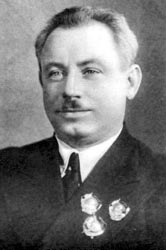
The leader of the "North Pole" station Ivan Papanin. Image courtesy Ecoshelf.
On February 1, 1938, the first polar drifting station “North Pole – 1” of the Soviet Union, while adrift by the shores of Greenland, suffered a major storm. The wind accelerating to 150 kilometers per hour caused the entire ice block the station was based on to crack into small pieces. The people were left on a chunk barely 30 by 50 meters big, while their food and other belongings were swept away on another chunk of the block. Fortunately for the scientists, the radio transmitter stayed unbroken, which literally saved their lives, as they were able to call for help in time.
Though the general exploration of the north started as early as the late 18th Century, the serious step-by-step scientific reclamation of the Arctic only began in the 1920s. To learn more about the northern regions, polar stations, as well as sea and aviation ports, had been established on the shores of all northern seas. However, the most daring step was to set up a station which would actually be able to surf all the way to the North. This plan was put into operation by establishing, in 1937, the first drifting North Pole station, headed by the legendary Soviet scientist and explorer Ivan Papanin.
Before the expedition, from February 19 through 25 of 1937, Papanin organized a training course for his crew of three people, aiming to adjust them to the harsh conditions of the polar existence, as it required not only the exceptional health but a sufficient amount of stamina. The crew lived in a tent in one of the snow-clad fields in the Moscow region, drank water melted from the snow, and only fed on the polar ration. Later, the training base moved up north to the Franz Josef Land Archipelago, 900 kilometers from the North Pole.
After a thorough training course on May 21, 1937, the plane lifted Papanin’s four, also carrying tons of scientific equipment and food supplies. They even took Papanin’s private stamp he used to label his letters to Moscow and the crew’s favorite dog Cheerful.
The ice block Papanin’s crew landed on was, according to Papanin himself, “three-meters thick, drifting above five kilometers of water.” The ice block was three by five kilometers large and housed a tent, storage space, workshops, radio antennas, and a weather booth. The group’s major task was to observe the weather conditions. They worked 16 hours a day, simultaneously studying and keeping diaries. Papanin himself jazzed up his academic work by cooking meals for the rest of the crew.
Before the disaster cut into the group’s schedule, that is, from June 1937 till February, Papanin’s squad spent 274 days adrift, having traveled a total of 2500 kilometers. After the disaster occurred, and though the tiny ice block they were on could be squashed between the other bigger blocks at any moment, Papanin’s squad, left without any supplies, still tried to carry on working as they waited for the help to come.
The scientists were rescued on the fourteenth day of the drift by the “Taimyr” and “Murman” patrol vessels, with an icebreaker and a zeppelin also rushing to the site. On February 21, 1938, Papanin’s squad set their feet on board the Yermak icebreaker.
The scientists were greeted in Moscow as heroes, making the headlines of every paper, while playing “The Papanin Squad” became one of the favorite amusements among young boys.
The North Pole -1 station opened a new chapter in arctic exploration, giving way to setting up more elaborate stations, which even to this day contribute to the exploration of the Arctic.





No comments:
Post a Comment